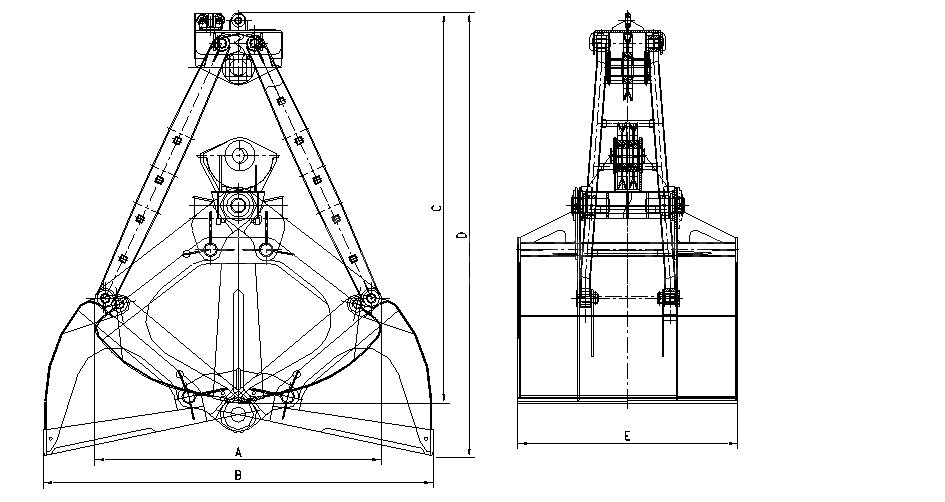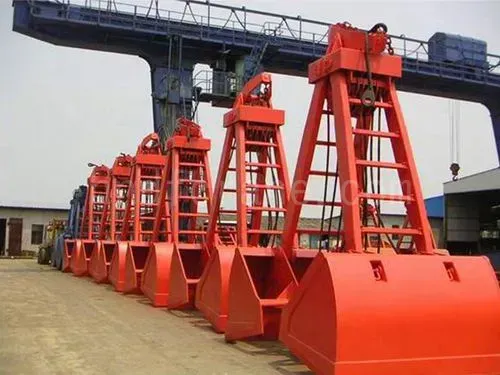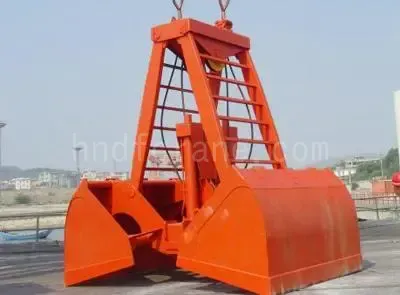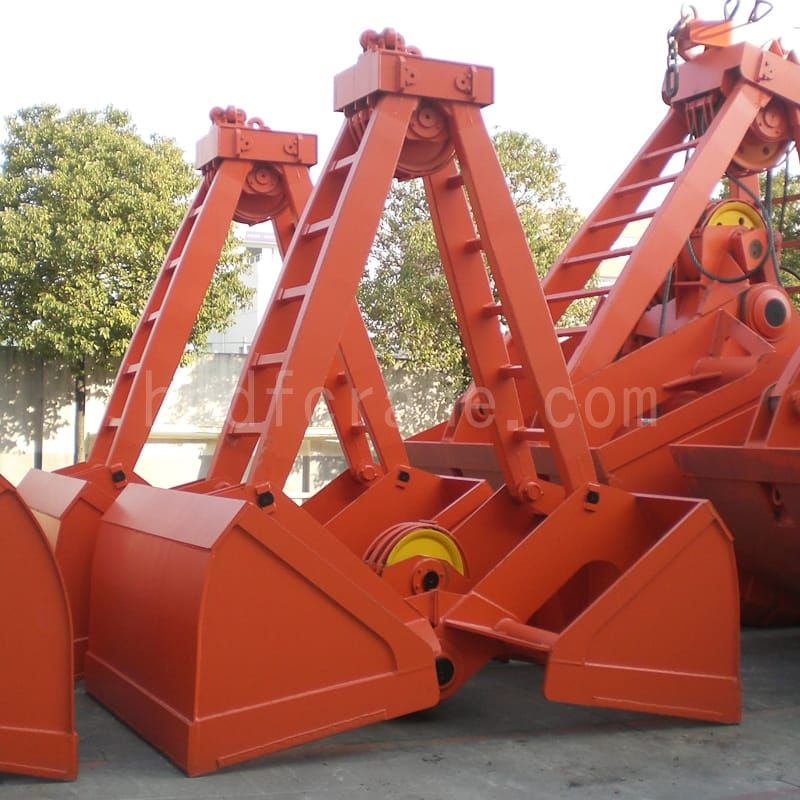Wprowadzenie do produktu: mechaniczne chwytaki dwulinowe
Mechaniczny chwytak dwulinowy przeznaczony jest do wszystkich rodzajów dźwigów z podwójną konstrukcją urządzenia podnoszącego. Najczęściej wykorzystuje się go w portach, dokach, na budowach dróg i mostów oraz w innych gałęziach przemysłu.
Zgodnie z charakterystyką materiału może być wyposażony w lekki, średni, ciężki i super ciężki. Nadaje się do chwytania wszelkiego rodzaju luźnych nagromadzeń.
Następnie różne dźwigi. Wyposażone w dwa zestawy bębnów silnikowych (tj. wciągniki elektryczne), każdy zestaw bębnów prowadzi do liny stalowej, z których jedna służy jako podpora na ramie równowagi chwytaka, a druga lina stalowa przechodzi przez koła pasowe górnej i dolnej belki, tworząc blok koła pasowego, który odgrywa rolę w otworze.
Mechaniczne chwytaki dwulinowe stanowią skuteczne narzędzie do załadunku i rozładunku ładunków masowych, takich jak żółty piasek, węgiel, proszek rudny i nawozy luzem, w różnych trudnych warunkach.
Mechaniczny chwytak dwulinowy charakteryzuje się prostą konstrukcją, nowatorskim mechanizmem otwierania i zamykania, łatwością obsługi oraz precyzyjnym wykonywaniem czynności otwierania i zamykania w różnych stanach.
Mechaniczne chwytaki dwulinowe przyjmują trójwymiarową wirtualną konstrukcję, a oprogramowanie ANSYS jest używane do analizy wytrzymałości i weryfikacji. Rozkład masy jest bardziej rozsądny, a żywotność dłuższa.
Górna belka nośna dwulinowych chwytaków szczękowych wyposażona jest w uchwyty, które można bezpośrednio połączyć z szeklą liny podnoszącej dźwigu.
Parametry techniczne mechanicznych chwytaków linowych dwuskrzydłowych

| Typ i rozmiar | Tom(M3) | Ciężar własny) | Wymiary (mm) | Średnica krążka.(mm) | Użyj wysokości(M) | Średnica liny stalowej(mm) | SWL(T) | ||||
| A | B | C | D | mi | |||||||
| BS3[1.2]1.3A | 1.2(300) | 1.4(4) | 1900 | 2537 | 2488 | 2841 | 1200 | ø400 | 9 | ø17,5 | 3 |
| BS3[1.6]1.4A | 1.6(300) | 1.4(4) | 2100 | 2631 | 2559 | 3040 | 1300 | ø400 | 9.5 | ø17,5 | 3 |
| BS5[1.5]2A | 1.5(350) | 2(3) | 2000 | 2659 | 2667 | 3075 | 1260 | ø445 | 8.5 | ø19,5 | 5 |
| 2(4) | 9.8 | ||||||||||
| BS5[2]2A | 2(350) | 2(4) | 2100 | 2778 | 2818 | 3248 | 1400 | ø445 | 10 | ø19,5 | 5 |
| BS5[2.5]2A | 2.5(350) | 2(3) | 2100 | 2787 | 2715 | 3091 | 1600 | ø445 | 8.5 | ø19,5 | 5 |
| BS5[3]2A | 3(400) | 2(3) | 2300 | 3130 | 2938 | 3362 | 1650 | ø445 | 9 | ø19,5 | 5 |
| BS8[2.6]3.2A | 2.6(300) | 2.6(4) | 2300 | 3038 | 3257 | 3736 | 1800 | ø560 | 11 | ø26 | 8 |
| BS8[3]3.3A | 3(300) | 3.3(4) | 2380 | 3118 | 3287 | 3786 | 1900 | ø560 | 11.5 | ø26 | 8 |
| BS8[3.8]3.5A | 3.8(300) | 3.5(4) | 2550 | 3536 | 3286 | 3733 | 2000 | ø560 | 12 | ø26 | 8 |
| BS8[4.5]3.8A | 4.5(300) | 3.8(3) | 2500 | 3505 | 3503 | 3975 | 2300 | ø560 | 12 | ø26 | 8 |
| BS10[3]4A | 3(300) | 4(4) | 2380 | 3118 | 3287 | 3786 | 1900 | ø560 | 11.5 | ø28 | 10 |
| BS10[5]4A | 5(350) | 4(4) | 2615 | 3605 | 3503 | 3975 | 2400 | ø560 | 12 | ø28 | 10 |
| BS10[6]4A | 6(400) | 4(4) | 2800 | 3814 | 3758 | 4290 | 2150 | ø560 | 12.5 | ø28 | 10 |
| BS16[3.6]6A | 3.6(300) | 6(5) | 2500 | 3313 | 3810 | 4206 | 2100 | ø720 | 13.5 | ø32 | 16 |
| BS16[4]6A | 4(350) | 6(5) | 2500 | 3313 | 3810 | 4206 | 2200 | ø720 | 13.5 | ø32 | 16 |
| BS16[6]6A | 6(350) | 6(4) | 2900 | 3800 | 4249 | 4612 | 2400 | ø720 | 13.5 | ø32 | 16 |
| BS16[10]6A | 10(400) | 6 (3) | 3200 | 4000 | 3938 | 4673 | 2500 | ø650 | 12 | ø28 | 16 |
Jak wybrać odpowiedni chwyt
- Wyjaśnij swój cel:
Zanim zagłębisz się w opcje, wyjaśnij swoje szczegółowe wymagania. Zadaj sobie pytanie:
- Z jakimi materiałami chcesz mieć do czynienia? (Kłody, złom, kamień, itp.)
- Jakie zadania będzie wykonywał chwytak? (Załadunek, sortowanie, demontaż itp.)
- Do jakiego typu urządzenia będzie podłączony? (Suwnica bramowa, suwnica)
- Jaki jest ciężar właściwy chwytanego materiału? Jaka jest liczba kostek chwytaka?
Jaki jest tonaż Państwa dźwigu wyposażonego w chwytak?
Ze względu na właściwości chwytanego materiału chwytaki dzieli się zazwyczaj na cztery podstawowe typy: lekkie, średnie, ciężkie i superciężkie.
| Rodzaj materiału do uchwycenia | Chwyć materiał | Waga nośna (t/m³) |
| Światło | Koks, żużel, zboża, ziemniaki, średniej jakości wapno antracytowe, cement, gleba, żwir, glina, pokruszone cegły itp. | 0.5~1.2 |
| Średni | Torf, duże bryły węgla antracytowego, ubity węgiel, glina, wapień, żwir, sól, żwir, cegły, boksyt, płatki tlenku żelaza, cement, piasek i cegły w wodzie itp. | 1.2~2.0 |
| Ciężki | Wapień, ciężka glina, rudy drobne i średnie, twarda skała, prętowy tlenek żelaza, ruda żelaza, proszek koncentratu ołowiu itp. | 2.0~2.6 |
| Nadwaga | Duże rudy, duża ruda manganu, osadowy aglomerowany proszek rudy ołowiu itp. | 2.6~3.3 |
- Zgodność akcesoriów: Upewnij się, że chwytak jest kompatybilny z istniejącym sprzętem.
- Rozważania budżetowe: Zakres cen chwytaków jest różny. Przy ustalaniu budżetu należy wziąć pod uwagę funkcjonalność i trwałość chwytaka.
- Komentarze i sugestie: Przeprowadź badania online, przeczytaj opinie użytkowników i poproś o sugestie kolegów z branży.
- Przed zakupem należy udać się do producenta dźwigu w celu przeprowadzenia inspekcji i testów na miejscu: Przetestuj chwytak w warunkach rzeczywistych tak często, jak to możliwe. Oceń jego wydajność, łatwość użytkowania i ogólną funkcjonalność.
Należy pamiętać, że wybór odpowiedniego chwytaka wymaga zachowania równowagi między funkcjonalnością, bezpieczeństwem i kosztami. Biorąc pod uwagę te fakty,



















































































